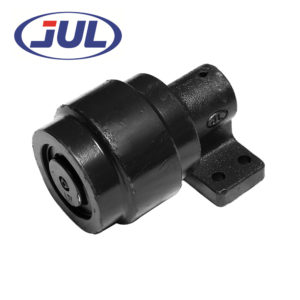Excavator carrier rollers, also known as upper rollers, play a significant role in supporting the excavator’s track chain and affecting its traction and grip.
Here’s how carrier rollers influence traction and grip:
- Track Tension: Carrier rollers help maintain proper track tension by supporting the weight of the track chain. Adequate track tension ensures optimal contact between the track shoes and the ground, maximizing traction and grip. If carrier rollers are worn or damaged, they may fail to support the track chain properly, leading to inadequate track tension and reduced traction.
- Track Alignment: Carrier rollers assist in guiding the track chain along its path of movement, helping to maintain proper track alignment. When the track chain is aligned correctly, the track shoes make consistent contact with the ground, ensuring even weight distribution and maximizing traction. Misaligned track chains can cause uneven wear on track shoes and reduce overall traction.
- Ground Contact: Carrier rollers make contact with the ground as the excavator moves, distributing the weight of the machine across the track chain. This helps prevent excessive ground pressure and minimizes track sinking into soft or loose terrain. The more carrier rollers are in contact with the ground, the better the weight distribution and traction.
- Resistance to Deformation: Carrier rollers are designed to withstand heavy loads and resist deformation during operation. When the excavator encounters obstacles or uneven terrain, carrier rollers maintain their shape and provide stable support for the track chain. excavator roller carrier This ensures consistent ground contact and traction, even under challenging conditions.
- Terrain Adaptability: Carrier rollers are designed to adapt to various terrain conditions, including rocky, muddy, or uneven surfaces. Their smooth surface and rolling motion allow them to navigate obstacles and maintain traction across different terrains, enhancing the excavator’s grip and stability.
- Maintenance and Lubrication: Proper maintenance and lubrication of carrier rollers are essential for ensuring optimal performance and traction. Regular inspection and lubrication of carrier roller bearings prevent friction and wear, ensuring smooth rotation and consistent ground contact. Worn or damaged carrier rollers should be replaced promptly to maintain traction and prevent further damage to the track chain.
Overall, excavator carrier rollers play a critical role in maintaining track tension, guiding track alignment, distributing weight, resisting deformation, adapting to terrain conditions, and ensuring proper maintenance and lubrication. By supporting the track chain effectively, carrier rollers enhance traction and grip, allowing the excavator to operate safely and efficiently in various construction and earthmoving applications.
How does carrier roller design differ for different types of roller?
Carrier roller design can vary significantly depending on the specific requirements of different types of excavators and the operating conditions they encounter.
Here’s how carrier roller design may differ for different types of rollers:
- Standard Carrier Rollers: Standard carrier rollers are typically used in conventional excavator designs and feature a simple, cylindrical shape. They are designed to provide basic support and guidance for the track chain while maintaining optimal track tension and alignment. Standard carrier rollers may have sealed or lubricated bearings, depending on the manufacturer’s specifications.
- Heavy-Duty Carrier Rollers: Heavy-duty carrier rollers are designed for use in rugged terrain and heavy-duty applications, such as mining, quarrying, and demolition. They feature reinforced construction, larger diameter bearings, and thicker outer shells to withstand higher loads and impact forces. Heavy-duty carrier rollers may also have specialized seals or protective coatings to resist abrasion and corrosion.
- Sealed Carrier Rollers: Sealed carrier rollers are designed to minimize maintenance requirements and prevent contamination of internal components. They feature sealed bearings or bushings that are pre-lubricated and sealed against dirt, moisture, and debris. Sealed carrier rollers are ideal for applications where regular maintenance is challenging or access to the undercarriage is limited.
- Center-Guided Carrier Rollers: Center-guided carrier rollers feature a central flange or guide that helps keep the track chain centered on the roller. This design prevents lateral movement and ensures proper track alignment, reducing wear on the track shoes and other undercarriage components. Center-guided carrier rollers are commonly used in applications where precise track alignment is critical, such as on steep slopes or in confined spaces.
- Offset Carrier Rollers: Offset carrier rollers have an offset design where the roller is positioned slightly off-center from the track chain. This design helps distribute the load more evenly across the track shoes and reduces wear on the inner edges of the track shoes. carrier roller supplier Offset carrier rollers are often used in applications where track wear is a concern, such as in abrasive or rocky terrain.
- Maintenance-Friendly Carrier Rollers: Some carrier roller designs feature quick-change or bolt-on components that make maintenance and replacement easier and more efficient. These designs may include removable bearing cartridges, snap-on seals, or accessible mounting hardware that allows for rapid replacement of worn or damaged components without disassembling the entire undercarriage.
- Specialized Carrier Rollers: In addition to standard designs, there are specialized carrier rollers available for specific applications or environmental conditions. For example, low-temperature rollers are designed to operate in extreme cold environments, while high-temperature rollers are resistant to heat and thermal expansion. Similarly, corrosion-resistant rollers are available for use in corrosive or marine environments.
Overall, carrier roller design may vary based on factors such as load capacity, terrain conditions, maintenance requirements, track alignment needs, and environmental considerations. By selecting the appropriate carrier roller design for a given application, excavator operators can ensure optimal performance, durability, and reliability of the undercarriage system.
